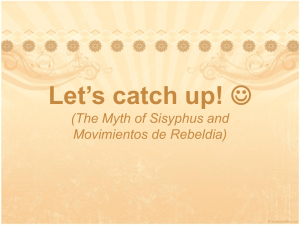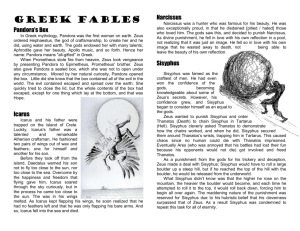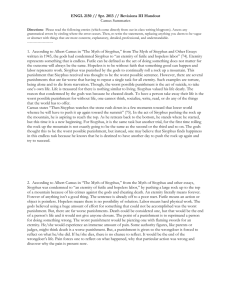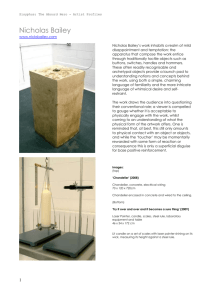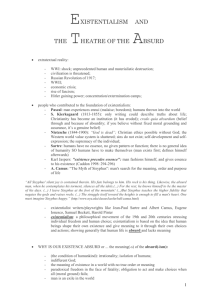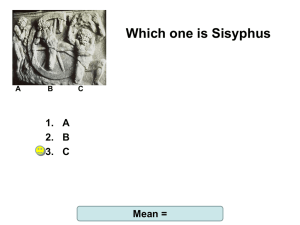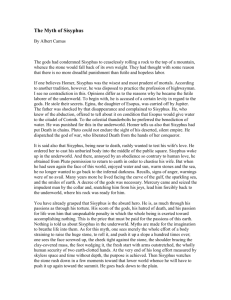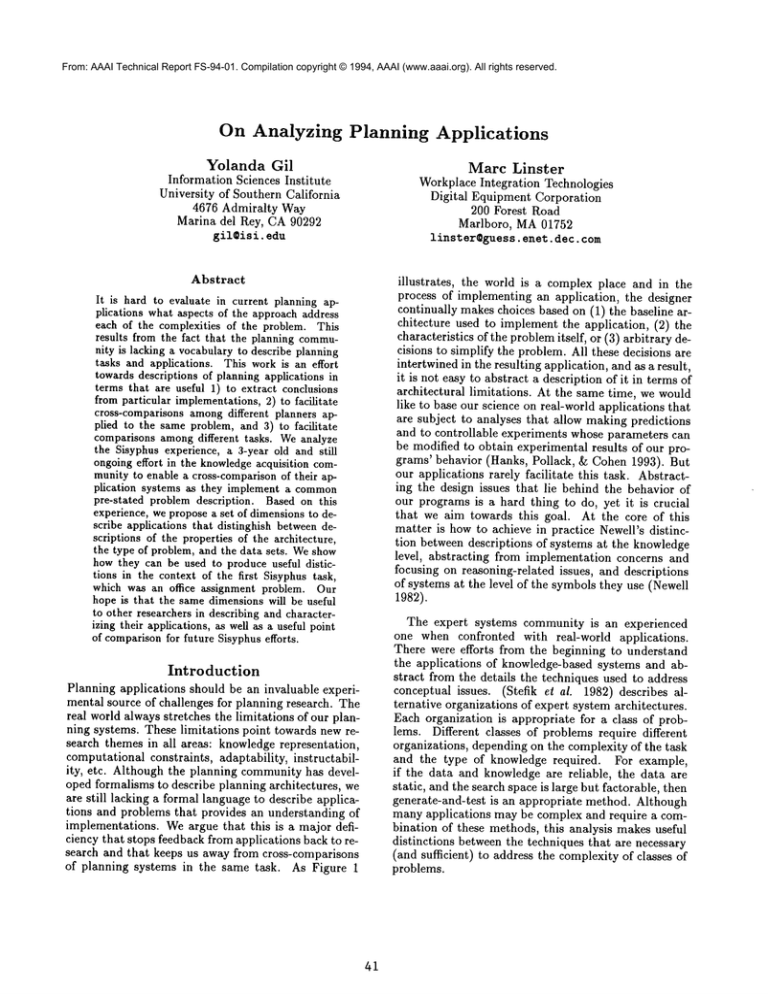
From: AAAI Technical Report FS-94-01. Compilation copyright © 1994, AAAI (www.aaai.org). All rights reserved.
On Analyzing
Planning
Yolanda Gil
Applications
Marc Linster
Information Sciences Institute
University of Southern California
4676 Admiralty Way
Marina del Rey, CA 90292
gil@isi, edu
Workplace Integration
Technologies
Digital Equipment Corporation
200 Forest Road
Marlboro,
MA 01752
linst er@guess,enet. dec. com
Abstract
illustrates,
the world is a complex place and in the
process of implementing an application,
the designer
continually makes choices based on (1) the baseline architecture
used to implement the application,
(2) the
characteristics of the problem itself, or (3) arbitrary decisions to simplify the problem. All these decisions are
intertwined in the resulting application, and as a result,
it is not easy to abstract a description of it in terms of
architectural
limitations.
At the same time, we would
like to base our science on real-world applications that
are subject to analyses that allow making predictions
and to controllable
experiments whose parameters can
be modified to obtain experimental results of our programs’ behavior (Hanks, Pollack, & Cohen 1993). But
our applications rarely facilitate
this task. Abstracting the design issues that lie behind the behavior of
our programs is a hard thing to do, yet it is crucial
that we aim towards this goal. At the core of this
matter is how to achieve in practice Newell’s distinction between descriptions
of systems at the knowledge
level, abstracting
from implementation concerns and
focusing on reasoning-related
issues, and descriptions
of systems at the level of the symbols they use (Newell
1982).
It is hard to evaluate in current planning applications what aspects of the approach address
each of the complexities of the problem. This
results from the fact that the planning community is lacking a vocabulary to describe planning
tasks and apphcations. This work is an effort
towards descriptions of planning applications in
terms that are useful 1) to extract conclusions
from particular implementations, 2) to facilitate
cross-comparisons among different planners applied to the same problem, and 3) to facilitate
comparisons amongdifferent tasks. We analyze
the Sisyphus experience, a 3-year old and still
ongoing effort in the knowledge acquisition community to enable a cross-comparison of their application
systems as they implement a common
pre-stated problem description.
Based on this
experience, we propose a set of dimensions to describe applications that distinghish between descriptions of the properties of the architecture,
the type of problem, and the data sets. Weshow
how they can be used to produce useful distictions in the context of the first Sisyphus task,
which was an office assignment problem. Our
hope is that the same dimensions will be useful
to other researchers in describing and characterizing their applications, as well as a useful point
of comparison for future Sisyphus efforts.
The expert systems community is an experienced
one when confronted
with real-world
applications.
There were efforts
from the beginning to understand
the applications
of knowledge-based systems and abstract from the details the techniques used to address
conceptual issues. (Stefik el al. 1982) describes alternative organizations of expert system architectures.
Each organization is appropriate for a class of problems. Different classes of problems require different
organizations,
depending on the complexity of the task
and the type of knowledge required.
For example,
if the data and knowledge are reliable,
the data are
static, and the search space is large but factorable, then
generate-and-test
is an appropriate
method. Although
many applications
may be complex and require a combination of these methods, this analysis makes useful
distinctions
between the techniques that are necessary
(and sufficient)
to address the complexity of classes
problems.
Introduction
Planning applications
should be an invaluable experimental source of challenges for planning research. The
real world always stretches the limitations of our planning systems. These limitations
point towards new research themes in all areas: knowledge representation,
computational constraints,
adaptability,
instructability, etc. Although the planning community has developed formalisms to describe planning architectures,
we
are still lacking a formal language to describe applications and problems that provides an understanding of
implementations.
We argue that this is a major deficiency that stops feedback from applications back to research and that keeps us away from cross-comparisons
of planning systems in the same task. As Figure 1
41
that were used in (Linster 1993b) to evaluate the first
two rounds of the Sisyphus experiment and some of
the conclusions that we drew using those dimensions.
Then, we enumerate a set of distinctions that we deem
useful to compare applications of planning architectures to the same problem.
Drawing
from the Sisyphus
Experience
The goal of Sisyphus is to compare different methodological approaches to the engineering of knowledgebased systems, and to provide a set of meaningful datapoints to enable further analysis. Each year, a Sisyphus conference is held organized around a problems
that should each be solved by the different research
teams. Each participating
team develops a solution
using its own methodology or tool. The solutions are
presented to foster comparison, discussion, and to serve
as data-points to relate different approaches. In 1991,
two problems were proposed: one was concerned with
the analysis of textual material related to the rigging of
sailboats, and the other was an assignment problem of
people to offices. In 1992, a slightly modified version
of the latter was used. In 1993, a complex elevator
configuration task was chosen (Sandra Marcus 1988;
Marcus & McDermott 1989; Yost 1993). We focus our
discussion on the office assignment problem, because 1)
it is the most manageablein size, 2) it is the one that
has been implemented by most groups to date, and
3) it has already produced some comparative studies.
The problem is described briefly in the Appendix. We
now summarize the dimensions for comparing systems
in one of the studies mentioned in which we based the
discussion presented in the rest of the paper.
Figure 1: Applications are shaped by the architecture
used, the characteristics
of problems they automate,
and assumptions about the problem made by the designers.
The knowledge acquisition community, continuing
this quest for automating expertise into real-world applications has taken an alternative and perhaps more
empirical approach towards the same goal of understanding application systems. In 1990, during one of
their meetings (Wielinga et al. 1990), they decided to
publish several problem statements and ask research
groups from around the world to use their tools, methods, and approaches to provide solutions for the problems. The results would be presented at an annual
conference baptised Sisyphus. Their goal was to use
the different solutions to a same problem as a basis
for developing a commonvocabulary for the description and differentiation of knowledge acquisition approaches. Various previous camparisons (Karbach
VoB1991) had pointed out that the vocabulary used by
different research groups varied in terms and in meaning. Using a commonproblem statement would hopefully help clarify issues such as: what is the difference
between what different systems call actions, schemas,
knowledgesources, inference actions. Intuitively, there
are bound to be commonalities between their definitions, but each approach describes its building blocks
at a different grain size and using varying terminology.
Additionally, relating systems implementedin different
languages and using different algorithms forced the KA
communityto use knowledge-level abstractions. Sisyphus allowed the KAcommunity to develop a better
understanding of the different tools, approaches, and
representation schemes. Wedraw on their effort and
propose a set of dimensions that can be used to describe planning applications in a way that facilitates
identifying the architectural issues behind the implementation.
First, we will give a brief review of tile Sisyphus experiment, the problem statement, and the solutions
submitted by different groups in the knowledgeacquisition community.Wewill describe a set of dimensions
Dimensions
for comparison
Linster (Linster 1993b) compares several Sisyphus solutions along different dimensions to address the following questions:
1. What are the building blocks of the model?
2. Which components are generic, which are nonreusable?
3. What is the purpose of the tool/methodology (e.g.,
code generation, visualization, conceptualization,
elicitation,
knowledge management)?
4. Where in the development cycle is the tool or
methodology most useful?
5. Whois the user of the tool or methodology?
These dimensions reflect an engineering point of
view on knowledge modeling, instead of a cognitionoriented one. For example the analysis does not consider the adequacy of the models nor the efficiency of
the approaches in capturing the righl kind of knowledge (see (Burton e~ al. 1990) for such a study).
do not look at the methodological aspects of the approaches either, that is, we do not study how much
guidance they provide for the practitioner developing
42
a model (see (Allemang & Rothenfluh 1992) for such
a study).
refined and even undone if indicated by the ongoing
elaboration process. A more detailed description of
this view on the developmentcycle is given in (Linster
1993a).
1. Initial
knowledge acquisition.
The knowledge
engineer goes through initial interviews with the domain expert, records first protocols, and if possible
she uses techniques such as the knowledge acquisition grid (LaFrance 1987) to obtain initial structures
and to get a first overview of the application task.
2. Data interpretation
and knowledge structuring. The knowledge engineer identifies recurring
and potentially more abstract structures in the domain. These structures can be of different kinds.
What are the building
blocks used to model
knowledge? Building blocks were defined as discrete
and identifiable constructs that the framework provides to describe the knowledgethat goes into an application. Note that according to this definition interpreters or other predefined and invariable elements of
a system are not considered building blocks. Rules,
objects, knowledgesources, agents, classes, are examples of building blocks. The focus was on declarative
elements of the knowledge representation.
This appears to be the only clear boundary between generalpurpose programming languages, such as Lisp or HyperTalk and other means of representation that are
more commonlyreferred to as knowledge representation. Wewill distinguish three kinds of representational primitives: (1) domain-knowledge representation facilities; (2) methodelements, that is the elementary generic problem-solving building blocks, their
aggregation principles and the control description that
combines building blocks into problem-solving methods; and (3) primitives to connect method definitions
with domain knowledge.
What is the purpose of the tool/methodology?
Four categories of usage were employed to discuss the
different approaches: knowledge conceptualization, visualization, implementation, and knowledge management. A tool helps in the conceptualization phase if it
allows to represent observations and interpretations of
observations previous to their formalisation, and if it
supports the user in the transition from informal to formal knowledge. Werefer to a tool as a knowledgevisualisation tool if its interface emphasizesgraphical communication of knowledge. For a tool to be categorized
as an implementation tool it must provide directly operational formalisms or strong methodological support
to transform pre-operational knowledge into an operational representation. Simply attaching an editor for
Lisp code doesn’t do it. Moreover, delivering running
systems must be the intention of the tool developers,
as opposed to tools built to deliver executable specifications or feasability studies. Knowledgemanagement
refers to repository, dictionary, and browsingcapabilities for the tool’s knowledgerepresentation primitives.
An environment provides active knowledge acquisition
support if it derives guidance for the ongoing acquisition from the current contents of its knowledgebase.
Where in the development cycle is the tool most
useful? The study used a description of system development as a cyclic process consisting of a set of
distinct activities. These activities are organized in
a logical sequence, not to be confused with a waterfalloriented series of phases; we see them as being the
central activities of a spiral developmentcycle, so that
all phases can be repeated and previous results can be
of domain structures.
The
(a) Identification
knowledge engineer develops a structured terminology for the domain, for example she can define
a T-box in KL-ONE-like approaches (Brachman
&Schmolze1985) or a set of classes in an objectoriented approach.
of inferences and roles that
(b) Identification
knowledge elements play in the problemsolving process. The knowledge engineer defines
the actions, goals, and decision criteria to give an
abstract (possibly knowledgelevel) description
the problem-solver.
(c) Identification
of other structures, such as,
task sharing, task decomposition, data flow, or
modality.
and mapping of the different
(d) Integration
structures
into a coherent model of the
task. The different knowledge structures, identified in the previous phases, must be merged into
a coherent model. This phase is most important,
as it represents the creative interaction between
the different points of view represented by the different knowledgestructures.
3. Acquisition
of the detailed knowledge in the
framework defined
by the task model. The
model of the task provides structures that are now
stuffed with detailed knowledge about the application.
4. Knowledge implementation.
The task model is
1.
transformed into an operational system
5. Testing and debugging.
after system deliv6. Knowledge maintenance
ery. Wedistinguish two types of knowledge maintenance:
(a) Maintenance of the structures that constitute the framework of the task model. If
structures are modified, then this changes the task
model. Such modifications require re-engineering
1Obviouslythis phase is obsolete if the task modelis
defined using operational primitives.
43
of the task model, and if necessary, restructuring
of the detailed knowledge.
(b) Maintenance of the detailed
knowledge in
the structures of the task model. Within the
framework of the task model, maintenance of the
detailed knowledgeis similar to the acquisition of
the detailed knowledge.
This distinction depends strongly on the implementation phase. It can only be drawn if the implementation maintains the distinction between structures
of the task model and the detailed knowledge.
Who is the user? The study differentiated
between
four classes of users: (1) domainexperts, that is, users
with a lot of knowledgeof the area that the tool will
be used in, but without systems analysis skills and little or no programmingknowledge; (2) knowledge engineers, that is, people with good systems analysis and
programming skills; (3) analysts, such as workplace
analysts, who do not necessarily have programming
knowledge; and (4) teams consisting of domain experts
working under the guidance of knowledge engineers or
analysts.
Some conclusions
Manydifferent approaches were used to solve the Sisyphus tasks, including configuration design, situated
classification, constraint satisfaction, and genetic algorithms (Linster 1994). After categorizing the Sisyphus
contributions in this framework, we drew conclusions
such as the following ones:
If one wants to support the creative aspects of
model building in the early phases of knowledgeacquisition, then having independent languages for
method and domain modeling appears to be crucial.
If one wants support for initial knowledge acquisition and bottom-up structure development,
then one is boundto get little help for the acquisition and maintenance of the detailed knowledge.
If one wants to have good support for the implementation phase, the acquisition and maintenance of the detailed knowledge, then one should
use a shell.
Given the wide variation in the approaches taken by
the different participants, it is clear that any of the
approaches could successfully implement the Sisyphus
problem statements. The question is not whether we
can implement an application using a certain kind of
approach, since this seems to have a clearly positive
answer. Rather, the question is whether our implementations can support the additional functionalities
that real applications demand. Can these systems be
corrected if the designers had any misconceptions or
misunderstandings about the task they were automating? Can these systems support additional functionalities that applications mayrequire, such as explanation,
adaptation, and scaling up? Webelieve that the next
step is to analyze each contribution along the lines by
which they would be evaluated to determine their success as office assignment tools. To do so, we propose a
set of dimensions that can makeuseful distinctions regarding this kind of analysis. Building on these observations drawn from the Sisyphus experience, we hope
that they will be useful to analyze planning domains
and planning applications.
Comparing
Architectures~
Applications
and Problems
In order to produce useful descriptions of planning applications, it is important to makedistinctions between
the planning architecture, the problem that the application is trying to address, and the application itself.
A planner is any system that implements a planning
algorithm. SNLP(MeAllister &: Rosenblitt 1991) is
example of a planner. An architecture is a domainindependent system that combines different aspects of
reasoning. SOAR(Laird, Rosenbloom, &: Newell 1986)
is an example of an architecture. For planning applications, we are interested in architectures that have some
kind of planning capability.
A problem states the constraints posed by a set of
situations in a domain and the requirements of desired
solutions. Typically a solution is found for particular
instances of a problem, which we will call data sets. Examples of problems are Blocks World and the STRIPS
robot problem (Fikes & Nilsson 1971). ta sk is a d escription that encompasses a class of problems. For
example, robot navigation tasks.
Anapplication is the system that results from applying a problem-solving architecture to a problem. Notice that the same architecture applied to the same
problem mayresult in a different application if the architecture offers different alternatives for modelingthe
same problem.
The dimensions presented in the previous section are
useful to define which aspects of a problem an application addresses. However, they are more focused on issues that are directly relevant to work on knowledgeacquisition, such as the type of user and tool support during the development of the application. Planning applications should address these issues to some degree,
since these are issues that arise with any real application. But in order to understand the planning architecture itself, we need to abstract additional things from
the applications that are more directly relevant to planning research. The following subsections present some
dimensions that we believe are useful to describe planning architectures,
problems, and applications. Our
aim is not to be comprehensive, but rather to present
what we believe are useful factors to analyze applications.
Describing
an Architecture
1. Scope of Architecture
¯ task coverage -- types of tasks that the architecture can be used for
¯ capabilities -- types of reasoning that the system
is able to do: uncertainty, default reasoning, learning, etc.
2. Representations
¯ state descriptions -- what formalism is used to
represent static descriptions of objects? is there a
representation of time?
¯ procedural knowledge -- can the system represent deduction rules? can action changes be represented?
¯ decisions -- can preferences be expressed explicitely? can constraints be represented?
3. Finding solutions
¯ search strategy -- how does the system find solutions?
¯ search control -- are there domain-independent
search-control
mechanisms? how is domaindependent search-control knowledge formulated?
¯ abstraction -- is there an abstraction mechanism
in the system?
4. Building blocks used to construe the problem and
phrase the solution
¯ generic building blocks
¯ grain size of building blocks
¯ knowledge-level vs. symbol-level building blocks
¯ formal vs. operational vs. informal
¯ process vs. structure oriented building blocks
5. Activities supported in the development cycle of an
application
¯ elicitation
¯ knowledge structuring
¯ acquisition of detailed knowledge
¯ knowledge implementation
¯ testing
¯ maintenance
6. Adaptability -- can the system evolve as its environment requires?
¯ execution -- can the system handle unexpected
events during plan execution?
¯ learning -- does the system adapt autonomously,
or does it require manual adaptation?
¯ factual knowledge -- how can objects and facts
be added/deleted/updated? can the same factual
knowledgebe used for a different task?
¯ task knowledge-- can the definition of the task be
changed? can the goal be changed and in which
ways?
7. Prototyping
¯ fast prototyping -- howmucheffort is required to
produce a working prototype?
¯ prototype complexity -- how much complexity of
representation is required for simple problems?
8. User-system communication
¯ User intervention -- Does the system share the
task with the user? This is a dimension spawned
by the following extreme points: (1) the user keys
in an instance of the problem statement; the system comes back with a ready-made solution; and
(2) the user and the system cooperate in solving
problems.
¯ inspection -- can the user understand how the system is solving a problem?
¯ explanation -- can the system justify its behavior?
Describing
a Problem
1. Entities
¯ types of objects
¯ properties of individual objects
¯ properties of classes of objects
¯ properties that relate objects
2. Actions and Change
¯ temporal considerations -- reasoning about events
and durations
¯ state transformations -- transitions and action
models
Restrictions
-- can be preferences or hard-set re3.
strictions
¯ restrictions on objects
¯ restrictions on actions
4. Solutions
¯ are there solutions to all the instances of the problem?
¯ criteria satisfaction -- does the problem require
satisficing solutions or are partially satisficing solutions sufficient?
¯ solution quality -- is there a notion of better quality solutions? can the user specify a range for the
quality of the resulting solution?
A problem does not necessarily need to be modelled
in these terms. Our intention in enumerating the above
set is rather to provide a list of issues that need to be
addressed in modelling the problem.
Data sets instantiate the problem statement in all
the respects listed above. Data sets may consist of a
description of all the objects of each type and their
properties.
Describing
an Application
System
Representation
-the
knowledge
necessary
for solv1.
ing problems
¯ object types -- how many different types of objects?
¯ constraints -- are there restrictions in the way the
objects interact?
¯ relations -- are there relations amongobjects?
¯ actions -- what changes and transitions are possible?
¯ time -- does the system do some type of temporal
reasoning?
2. Search Space -- is the system exploring a search
space in finding a solution?
¯ branching factor -- what is the branching factor?
¯ search depth -- what is the depth of the search
tree?
¯ goal interactions -- howcan the interactions between goals be characterized? (independent, serializable vs non-serializable, positive vs negative)
¯ backtracking -- does the system ever need to backtrack?
¯ solution density -- what is the average solution
density when comparingthe size of the search tree
to the number of solutions?
3. Efficiency -- how does the system address the combinatorial complexity of the problem?
¯ quantitative measures -- empirical results on the
system efficiency
¯ qualitative measures -- a description of the mechanisms used to make the system efficient
4. Delivery -- what happens when the system is put to
use?
¯ users -- who are the users of the application?
does the system achieve a useful task according
to users?
¯ environment -- howdoes it fit in the overall work
environment?
3. project heads should be close to the group head.
4. twin offices should be shared by people in different
projects.
5. researchers are not eligible for single offices.
6. a non-smoker cannot share a room with a smoker.
¯ criteria satisfaction -- solutions that satisfy all the
constraints are preferred if they exist. Otherwise,
solutions that satisfy most of the criteria are acceptable.
The data set provided made the problem relatively
simple. For example, there were a lot of double-size
and single-size offices compared to how many people
needed to be assigned. There were only 4 smokers.
There were 8 projects, each of 1-3 people. These data
made the constraints relatively easy to satisfy. The
participants in the Sisyphus conferences describe their
systems with a focus on how this particular problem
and data were implemented with their architecture.
While it is interesting to see that an architecture can
represent and solve this problem with the data proposed, it may be more useful to focus on how the architecture would implement alternative definitions of
this problem. This was tried out when the conference
organizers issued a second statement of this Sisyphus
problem (described at the end of the Appendix) is
variant of the first data set but with one more smoker.
This small change produced a data set that had no satisficing solution, which madesome architectures fail to
return any solution at all. This sort of exercise is very
useful to understand the strengths and weaknesses of
an architecture. But it is nonetheless a small variation
along one single dimension. It would be interesting to
learn howthe different alternative architectures compare in other dimensions. For example, how would the
system’s performace be affected if:
¯ More rooms, more people, more projects (this would
test scaling up issues)
¯ More (and more problematic) smokers (as in second
Sisyphus task, but more than one)
¯ More managers
¯ More people in each project
¯ Absolutely no assignments with smoker/non-smoker
¯ Hackers cannot share rooms with non-hackers
¯ Newtypes of workers (e.g., visiting researchers)
¯ Required to respect officemate assignments as they
are currently stand in the building before the group
movesto the castle
¯ The user has strong preferences on which constraints
to violate
Notice that the data determines whether a constraint in the problem definition is makingthe problem
hard to solve. In this case, the fact that the number
of smokers is even makes this data set simpler to solve
with regard to the non-smoking constraint, compared
to data sets that include manysmokers. Andin the extreme, if there are no smokers at all then the constraint
becomesnonrelevant. Similarly, if there are manymore
The description of the application can also include a
more detailed account of the dimensions for describing
an architecture.
The Sisyphus
Problem
Revisited
The Sisyphus problem is an office assignment task. The
task consists on assigning a set of people into a set
of offices satisfying somegiven restrictions. An office
assignment task is a kind of assignment task.
As far as the particular office assignment problem
posed, it can be described as follows:
¯ types of objects: rooms, people, projects, job
types (group head, project head, manager, secretary,
project member)
¯ properties of individual objects: person x is a smoker
or a non-smoker, person x is a hacker or a staff member, roomx is double or single size
¯ properties that relate objects: person x has job of
type y, person x works with person y, person x works
with person y.
¯ restrictions
double
1. single rooms accomodate one person,
rooms accomodate two.
2. there is only one group head
3. there is only one manager
4. there is only a project head per project
¯ preferences
1. offices of the group head and staff should be close.
2. group heads should be given a double-size office.
46
rooms than people, then this constraint does not really
affect the complexity of the problem.
It is noticeable that the planning and knowledge acquisition communities usually base their analyses in almost mutually disjoint items from the list above. The
planning community focuses mostly on computational
efficiency, while the knowledge acquisition groups concentrate on modeling, knowledge representation,
and
system development.
Are our planning systems concerned only with execution issues? Are our knowledge
acquisition
tools so submerged in the real world that
that there is not much room for computational issues?
We would expect the answers to be negative in both
cases. Our analyses and evaluations
in the two areas
should make an effort to- cover both grounds.
Tasks. In Wetter, T.; Althoff, K.-D.; Boose, J.; Gaines,
B.; Linster, M.; and Schmalhofer, F., eds., Current developments in knowledge acquisition-EKAW92, volume 599
of LNAI, 353 - 372. Heidelberg: GI, ECCAI.
Brachman, R., and Sehmolze, G. 1985. An overwiev of
the KL-ONEknowledge representation
system. Cognitive
Science 9(11):216-260.
Burton, A. M.; Shadbolt, N. R.; Rugg, G.; and Hedgecock, A. 1990. The efficacy of knowledge elieitation techniques: A comparison across domains and levels of expertise. Knowledge Acquisition 2(2):167 - 178.
Fikes, R. E., and Nilsson, N. J. 1971. STRIPS: A new
approach to the application of theorem proving to problem
solving. Artificial Intelligence 2(3-4):189-208.
Hanks, S.; Pollack, M. E.; and Cohen, P. R. 1993. Benchmarks, test beds, controlled experimentation, and the design of agent architectures.
AI Magazine 14(4).
Karbach, W., and Vofl, A. 1991. Glueing together small
solutions:
An office planning model in MODEL-K.In
Linster, M., ed., Sisyphus’91: Models of problem solving,
volume 663 of Technical Report. St. Augustin: GMD.
LaFrance, M. 1987. The knowledge acquisition grid: A
method for training knowledge engineers. Int. Journal of
Man-Machine Studies 26:245-255.
Laird, J. E.; Rosenbloom, P. S.; and Newell, A. 1986.
Chunking in SOAR: The anatomy of a general learning
mechanism. Machine Learning 1(1):11-46.
Linster, M. 1993a. Explicit and operational models as
a basis for second generation knowledge-acquisition tools.
In David, J.-M.; Krivine, J.-P.; and Simmons, R., eds.,
Second generation expert systems. Springer Verlag. 477 506.
Linster, M. 1993b. A review of Sisyphus 91 & 92: Models
of problem-solving knowledge. In Aussenac, N.; Boy, G.;
Gaines, B.; Linster, M.; Ganascia, J.-G.; and Kodratoff,
Y., eds., Knowledge Acquisition for Knowledge-Based Systems, volume 723. Toulouse: Springer Verlag.
Linster, M. 1994. Special Issue on Sisyphus: Models of
Problem Solving. Int. Journal of Human-ComputerStudies M. Linster (Ed.) 40 (2).
Marcus, S., and McDermott, J. 1989. SALT: A knowledge acquisition language for propose-and-revise systems.
Artificial Intelligence 39 (1): 1-37.
McAllister, D., and Rosenblitt, D. 1991. Systematic nonlinear planning. In Proceedings of the 1991 National Conference on Artificial Intelligence.
Newell, A. 1982. The knowledge level. Artificial Intelligence 18:87 - 127.
Sandra Marcus, Jeffrey Stout, J. M. 1988. VT: An expert
elevator designer that uses knowledge-based backtracking.
AI Magazine 9(1).
Stefik, M.; Aikins, J.; Balzer, R.; Benoit, J.; Birnbaum,L.;
Hayes-Roth, F.; and Sacerdoti, E. 1982. The organization
of expert systems: A tutorial. Artificial Intelligence 18(2).
Wielinga, B.; Boose, J.; Gaines, B.; Schreiber, G.; and
Someren, M. V., eds. 1990. Current Trends in Knowledge Acquisition;
Proceedings of EKAW90,Amsterdam:
ECCAI.
Yost, G. R. 1993. Sisyphus 1993: Configuring elevator systems. Technical report, Workplace Integration Technologies Group, Digital Equipment Corporation, 111 Locke
Drive (LM02/Kll), Marlboro, MA01752. Unpublished.
Appendix: The Office Assignment
Problems of Sisyphus ~91 and ’92
The task is described in detail in (Linster 1994).
essence, the members of a research group need to be
assigned to new offices. Their characteristics
are as
follows:
Per~gn
Thomu 0.
MonlkaX.
Ulrike U,
Eva L
JochimI.
Hans W.
KatharlnaN.
Andl L
UweT.
Werner L
JuergenI_
MarcM.
Angl W.
Harry C.
MichaelT,
R91
Smoker Hacker
~
groupleader no
no
secretary
no
no
secretary
no
no
man~Jer
no
no
pro| leader
no
no
yes
no
proJleader
proj leade¢
yes
yes
resemehe¢
yes
no
researcher
yes
yes
researcheq
no
yes
resewcher
no
yes
researche¢
no
yes
reseerche~
no
no
yes
researche¢
no
remmarcher no
yes
Project
EULISP
ASERTI
BABYLON
MLT
TUTOR/2000
AUT SYS
RESPECT
EULISP
KRITON
RESPECT
8ABYLON
BABYLON
~’~
RoomSize
C-113 S
C-114 S
C-115 S
C-11E Si
C-117 L
C-11fi L :
C-12¢ L !
C-121 L
C-122 L
C-123 L
The offices in the floor plan are numbered counterclockwise. In addition, the problem statement included
some restrictions
such as:
¯ offices of the group head and staff should be close.
¯ group heads should be given a double-size office.
¯ project heads should be close to the group head.
¯ twin offices should be shared by people in different
projects.
¯ researchers are not eligible for single offfices.
¯ a non-smoker cannot share a room with a smoker.
The problem statement contains additional
information that we do not include here because of lack of
space, including a sample protocol of an expert solving the problem.
The second version
of the problem stated
that
Katharina N. left the group and Christian I. joined
as a researcher
on the MLTproject that smokes and
hacks.
References
Ailemang, D., and Rothenfluh, T. 1992. Acquiring knowledge of knowledge acquisition: A self-study of Generic
47

